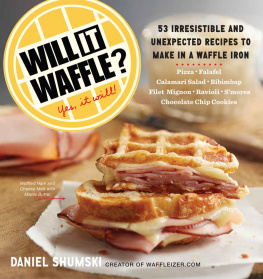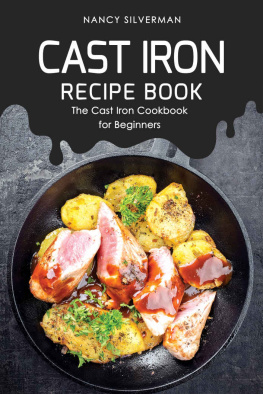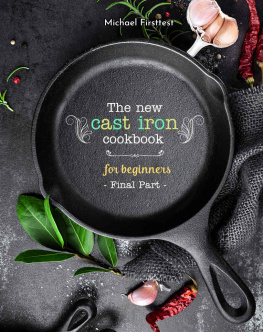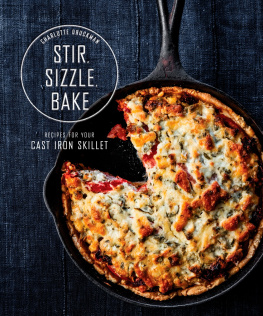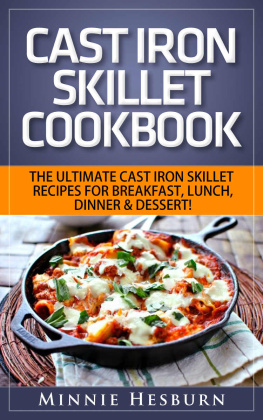
Will It Skillet?

53 IRRESISTIBLE AND UNEXPECTED RECIPES TO MAKE IN A CAST-IRON SKILLET
Daniel Shumski
Workman Publishing New York
To Bryan
Acknowledgments
M y thanks to those who bought my first book and made possible this second book. Those who read and supported the succession of blogs I did before that will always have my gratitude; following a story with no discernible middle or foreseeable conclusion isnt for the faint of heart or attention span. (Say what you will about my books, but at least you know when they will end.) Thank you to my editor, Megan Nicolay, for the inspiration and to my agent, Stacey Glick, for the encouragement. I am also very grateful for the efforts of Selina Meere, Jessica Wiener, Lauren Southard, Chloe Puton, Rachael Mt. Pleasant, Beth Levy, Anne Kerman, JeanMarc Troadec, Barbara Peragine, Doug Wolff, and the rest of the team at Workman Publishing, who have been known to work miracles. To Kerrie Ahern and the small cadre who tested these recipes, thank you for your perseverance and your dedication to saving me from myself. Finally, my moms feedback has always been valuableshe taught me how to drive, for example, and then continued to provide feedback on my driving for many years afterwardbut her comments on the recipes in this book were particularly helpful and made them that much better.
Contents
Chapter 2:
Chapter 3:
)
Chapter 4:
Chapter 5:
Developing Your Own Skillet Recipes
Introduction

I n my first book, I took a look at the waffle iron and elevated it from single-purpose appliance to everyday multitasker. But I heard from a lot of people who didnt have a waffle iron.
And I thought about what is truly indispensable in a kitchenthought about which single piece of equipment is uniquely versatile and remarkably durable. And I arrived at the cast-iron skillet: that rare cooking implement that is equally at home on the stovetop or in the oven, in a restaurant kitchen or over a campfire.
Lets think about it another way: You are going to a desert island. You can take one piece of cooking equipment. Do you take your saucier? Your slow cooker? A crepe pan, a cake pan, a casserole dish? The tart pan with the fluted edges? No. You take your skillet.
We know its versatile. But is it even more versatile than we might have thought? This cookbook you hold in your hands answers that question. (At the risk of blowing the big reveal, the answer is yes.)
Of course, this book is more a beginning than an end. As you see what your skillet is capable of, youll find yourself reaching for it more and more. And your skillet will reward that loyalty by becoming more beautiful and useful. Soon, you may find yourself asking and answering the question Will it skillet? Family recipes, ideas floating around the internet, dishes from favorite cookbooksall of them can be sources of inspiration and all of them just may find a new home in your skillet.
I cant wait to see what you cook up.
Chapter 1
Before You Begin
B efore we dive into the recipes, lets consider a few tips, techniques, and strategies. Maybe youve heard about seasoning cast iron and you get the idea its something you should do. But what is it exactly? Youre in luck! I will answer that question. Maybe youre wondering what shape and size your skillet should be. That is here, too.
I also delve into ingredients. Is a cup of flour always the same? Does the size of the eggs you use matter? Butter is butter and yeast is yeast, right? One-word answers: No, yes, no, and no. Now allow me a few more words and Ill lay it all out for you.
Choosing Your Skillet
Whats So Special About Cast Iron?
If youre not accustomed to cooking with cast iron, you should be aware of some of its unique properties.
First, lets talk heat. Cast iron is a relatively poor heat conductor compared to, say, aluminum. This means that the heat will travel relatively slowly and perhaps unevenly through a cast-iron skillet, especially as it begins to warm. That said, it stores heat very well, so it will take longer to cool down than other materials.
Next, theres the brute strength of cast iron. It is possible to crack it. Leaving it empty on the stovetop over high heat could cause this to happen eventually, but heres the thing: I cannot confirm this from personal experience, because in my decades of using cast iron, this has never happened to me. Youre more likely to hurt something (or, I suppose, someonebe careful!) with a cast-iron skillet than you are to damage the skillet itself.
Cast iron also holds incredible value. The racks of cookware stores are lined with pots and pans, some of which cost an astonishing amount of money and are far less versatile than cast iron. Is there a place for them? Maybe. If pressed, I will admit that I do own cookware beyond my cast-iron skillet. And yet what do I reach for most consistently? What has held up the best? What was among the least expensive pieces? My cast-iron skillet. (Well, skilletsI have six.)
Skillet Size
The recipes in this book were developed and tested using 10-inch skillets, as measured from outer rim to outer rim. A small variation shouldnt cause a problem, but beyond that the volume of the skillet can change quite a bit. Consider that a skillet 10 inches in diameter with a depth of 2 inches has a volume of about 10 cups, while a 12-inch skillet with the same depth has a volume of about 14 cups. Thats a 40 percent increase, which means those 2 inches make a big difference. That difference, in turn, will have a big impact on cooking time and temperature. Some thingsstir-fries, crepes, grilled cheesewill be forgiving of the size difference. Other thingscakes, muffins, pizzawill either not fit properly or require a different baking time or temperatureor some combination of both. The bottom line: For best results, stick to a 10-inch skillet at first; the experimentation can follow.
Manufacturers often assign a number to indicate the size of the skillet, but that number should not be confused with the measurement in inches. In many cases, for instance, a No. 8 skillet is about 10 inches across.
Shape and Materials
When it comes to skillet shape, its useful to have handles on two sides. An empty cast-iron skillet is heavy enough. When its full of food, having an extra spot to grab on to is handyparticularly when dealing with something hot from the oven.
The skillet should be all cast ironno wooden handles or plastic knobs or anything else that wont withstand high heat.

The Bottom Line
The recipes in this book were developed for and tested in 10-inch cast-iron skillets. Some recipes are more flexible than others. While using a skillet of another size or material may work in certain cases, it may also affect recipe results.
Seasoning Your Skillet
Here, seasoning doesnt mean salt and pepper. Think seasoned in the sense of experienced. Youre building up resistance in your skillet, keeping it impervious to the foods that pass through, andultimatelygetting it so slick that an egg wont stick to it. This happens because fats used in the skillet break down and reorganize at very high heat to form an excellent nonstick coating. This process is not instant! (More on this in a bit.)
Next page

